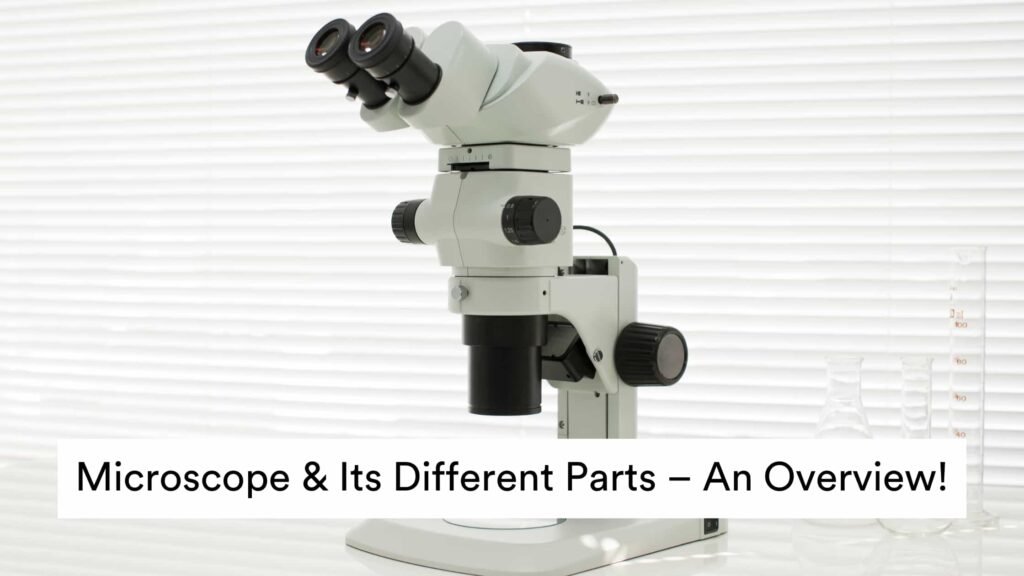It’s a piece of scientific apparatus that magnifies extremely minute objects that aren’t visible to the naked eye. Furthermore, a microscope allows us to observe and study organisms that we otherwise would not be able to see or study. It is an optical instrument that magnifies an item using a lens or a group of lenses. They also aid in the observation of many creatures. Microorganisms can also be seen with the use of a microscope’s light.
1) Types of Microscopes
The scope is of various types. These are:
2) Compound Microscope
It’s a device that contains two lenses. These are objective and ocular lenses. Additionally, they employ visible light as a light source.
3) Electron Microscope
It’s a scope that generates an image using an electron flow rather than light. Furthermore, the images of viruses, proteins, lipids, ribosomes, and even tiny molecules are enhanced by this microscope.
4) Fluorescence Microscope
Ultraviolet light is used to illuminate fluorescing specimens in these scopes. In addition, the viewing material is usually stained with a fluorescent antibody or dye.
5) Darkfield Microscope
A mechanism in these microscopes scatters light from the illuminator. This is also done to make the specimen stand out against the black background.
6) Contrast/Phase Microscope
A particular condenser in this scope enables the investigation of structures inside cells. They also employ the utilization of a compound light. Furthermore, for the examination of live organisms, these microscopes use different refractive indexes.
Furthermore, the final image created by these microscopes is a mix of light and dark.
Uses of Microscope
They are utilized in a variety of fields and for a variety of objectives. Tissue analysis, the evaluation of forensic evidence, determining the ecosystem’s health, investigating the role of protein within the cell, and the study of atomic structure are only a few of their applications.
Parts of Microscope
- Arm
It is located at the back of the microscope and serves to support the objectives as well as the ocular. Things are also the component that we use to raise or transport them.
- Base
It’s the very end of the range. It also holds the light source, and the base’s back half serves as a grip for carrying the scope.
- Course Focusing Knob
It’s used to fine-tune the location of the objective lenses. This should also be done with the goal of not having the objective hit the slide. It should also come to a halt when the thing is fully visible through the ocular.
- Fine Focusing Knob
Once the specimen is visible through the course-focusing knob, we utilize it to bring it into perfect focus. To avoid contact between the objective and the specimen, concentrate slowly.
- Illuminator
It is the microscope’s light source.
- Numerical Aperture of Objective Lens
The lens that is closest to the specimen in a compound scope is this one.
- Ocular lens
In a compound light microscope, this is the lens closest to the viewer.
- Oil Immersion Lens
This lens has a 100x objective. In order to achieve high resolution and magnification, this lens is also tiny. Furthermore, because of its small size, the lens requires as much light as possible.
- Condenser Part of Microscope
The microscope is regarded as one of science’s most impressive inventions. It has not only satisfied a lot of fundamental human curiosity about objects that are too small to see with the naked eye, but it has also saved a lot of lives.
The condenser’s job is to modify light’s direction and angles of reflection, not to enhance it in any way. The condenser regulates how much light from the illuminator is allowed to travel through the aperture, hence regulating the light’s intensity. It also regulates contrast, which is crucial. The contrast between distinct, drab-colored objects in the visual field is most significant in darkfield microscopy, not their appearance per se. They’re used to plucking out images that wouldn’t show up if the equipment was just used to blast the slide with as much light as the eyes above it could handle, leaving the spectator to hope for the best.
Micron Optik – Your Partner in Quality Microscopes
When you need high-quality microscopes for your laboratory, classroom, or facility, you can count on Micron Optik to deliver the best options available. For more than a decade, we’ve been a market leader in the distribution of microscopes, illuminators, task illumination, and replacement bulbs. We have the optical supplies you need to run your business smoothly, whether you’re in the electronics manufacturing or healthcare industries. Visit our website today to find the greatest microscope kits, components, illuminators, replacement bulbs, and more!
Thanks for reading!
People Usually Search Keywords: Microscope Manufacturers | Laboratory Microscope | Microscope Manufacturers in India | Microscope Supplier | Microscope Suppliers in India | Laboratory Microscope Suppliers | Microscope Manufacturers in Ambala | Microscope India | Best Microscope Manufacturers | Microscope Ambala | Microscope Online India | Microscope Brands in India | Microscope Companies in India | Microscope Online Shopping India | Top Microscope Brands in India | Indian Microscopes | Microscope India Suppliers | Top Microscope Manufacturers | Best Microscope Brands | Best Microscope Companies | Microscope Brands | Microscope Companies | Microscope Vendors
What Is a Binocular | Binocular Microscopy | Binocular Microscope | Binocular Microscopes | Binoculars Microscope | Microscope Binocular | Uses of Binocular Microscope | Binocular Microscope Principle | Microscope Comments | Microscope Definition Biology | Define Binocular | What Is Binocular
Uses of Microscope | What Is Microscope | 10 Uses of Microscope | Uses of Lenses in Our Daily Life | Explain Microscope | Define Microscope | 5 Uses of a Microscope | Convex Lens Uses in Daily Life | What Are Its Uses | Purpose of Microscope | Application of Simple Microscope | Use of Simple Microscope | Uses of Simple Microscope | Use of Microscope | Application of Microscope | Uses of Lens in Daily Life
Who Discovered Microscope | Who Invented Microscope | Who Invented the Microscope in 1666 | Zacharias Janssen Microscope | Who Discover Microscope | Who Made the Microscope | Microscope Invented by | Who Invented Compound Microscope | Who Invented the Microscope and When | Microscope Inventor Name | Who Founded Microscope | Microscope in Kannada
What Is a Compound Microscope | Compound Microscope Comments | Compound Microscope Information | Compound Microscope | Compound Microscope Explanation | Discovery of Compound Microscope | Why Is Light Microscope Called a Compound Microscope | Types of Compound Microscope | Compound Microscope Practical | Describe Compound Microscope | About Compound Microscope | Which Lens Is Used in Compound Microscope | Comments on Compound Microscope | Components of Compound Microscope | Explain Compound Microscope | History of Compound Microscope | Study of Compound Microscope




